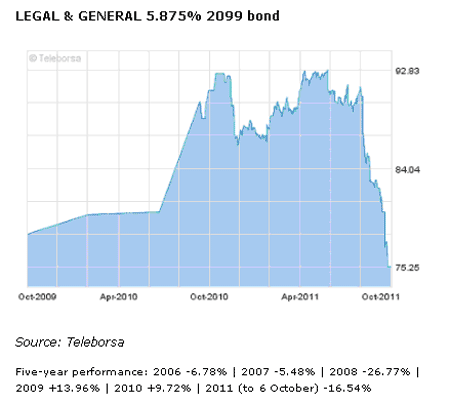
Well it didn’t exactly come as a bolt out of the blue. But I was a little surprised at the speed at which the Bank of England has stepped back up to the quantitative easing plate.
This week the Bank announced it would extend its asset purchase scheme by an extra £75bn. But this time around there was an important change in the rhetoric. Instead of focusing solely on gilts, this round of QE could well incorporate corporate bonds. And that could be great news for the sector – and maybe for us too.
It’s a sector that’s often ignored by private investors. But I think there’s a lot to be said for it.
A bold new move by the Bank of England
Here at The Right Side we’ve always suspected that 2011 would be the year of the double-dip recession. And this week brought news that the ONS have revised last quarter’s GDP figures downwards. Growth, it turns out was barely recognisable – the new figure is 0.1%.
All the same, I really didn’t think we’d be seeing any more QE until the economy actually keeled over. And if not flat on its back, I at least expected them to hold off until the Europeans got into the printing frame of mind.
I was wrong. It seems the Bank of England team were keen to get the first punch in. And they’ve hit hard as well as hitting first in this attack against the double-dip. £75bn of electronically created money is going to hit the markets over the next four months or so.
Make no mistake. This was a bold move. As the news broke, the pound plunged. And a low pound aggravates inflation – which of course is already way above target. Team Mervyn are going to face criticism for stoking inflation.
But what is bad news for inflation and the pocket of consumers looks like good news for one asset class. And it’s an asset that we’re keen on here at The Right Side.
Corporate bonds look set to benefit
Before Mr King hits the QE button, the chancellor, George Osborne writes him a letter giving him permission to press ahead with his grand plans. And in yesterday’s letter Osborne seemed pretty keen to push King towards using around £50bn (of the £75bn) on UK corporate bonds.
Now that would be quite a change from the previous £200bn, which nearly all went into buying gilts. Gilt yields are already low – so the Treasury now wants to have a stab at bringing corporate bond yields down too. Basically the Treasury wants corporate bond prices up and thus interest rates in the corporate world down.
Which bonds will they go for? Well, we don’t know, but it’s likely to be the biggest, most liquid issues. I dare say they’ll take aim at a fair few bank bonds too.
But we don’t have to know exactly which bonds are on the shopping list if we want to make a profit. That’s because whatever bonds get bid-up, it’ll tend to drag the rest of them up too. As the freshly minted money hits the market, much of it will end up re-invested into similar bonds, thus pushing all prices up.
On Wednesday, I mentioned a bond that I like the look of: The Legal & General 5.875% 2099 bond. It’s trading at 77p (with a par value of £1), which means that the effective interest rate is currently almost 8%.
Now I’m sorry if I caused some confusion over this bond. I have to admit that I missed a pertinent fact. Basically, although the bond runs until 2099, the interest rate will be reset in 2019 (and then every five years thereafter).
The reset rate will be the five-year gilt yield plus 2.33%. L&G also have the option to redeem the bond (ie, pay it off) on these five-year anniversaries.
But this still looks like a good deal to me. If L&G choose to redeem the issue in 2019, you’ll get back £100 for every £77 you’ve shelled out. And you’ll be picking up nearly 8% interest all the while.
If that happens, your yield to maturity will actually be over 10%. That rate factors in the capital profit of £23 (£100 redemption proceeds minus £77 you paid for the bond) over the period.
If they don’t redeem the bond, then after 2019 you’ll get whatever the five-year gilt pays, plus 2.33% on top for every bond you buy. And because you’re only paying 77p in the pound, you’ll effectively be getting nearly 1.3 times this nominal rate.
That looks like a good deal to me. But please remember, this bond isn’t guaranteed by anyone other than L&G. If L&G go bust, you may not get all, or any of your money back. As always, don’t put all your eggs in one basket.
But with the new focus on QE, this could be a very attractive prospect in the year ahead.
• This article is taken from the free investment email The Right side. Sign up to The Right Side here.
Important Information
Your capital is at risk when you invest in shares – you can lose some or all of your money, so never risk more than you can afford to lose. Always seek personal advice if you are unsure about the suitability of any investment. Past performance and forecasts are not reliable indicators of future results. Commissions, fees and other charges can reduce returns from investments. Profits from share dealing are a form of income and subject to taxation. Tax treatment depends on individual circumstances and may be subject to change in the future. Please note that there will be no follow up to recommendations in The Right Side.
Managing Editor: Frank Hemsley. The Right Side is issued by MoneyWeek Ltd.
MoneyWeek Ltd is authorised and regulated by the Financial Services Authority. FSA No 509798. https://www.fsa.gov.uk/register/home.do